中文和英语的区别
- 格式:doc
- 大小:27.00 KB
- 文档页数:2
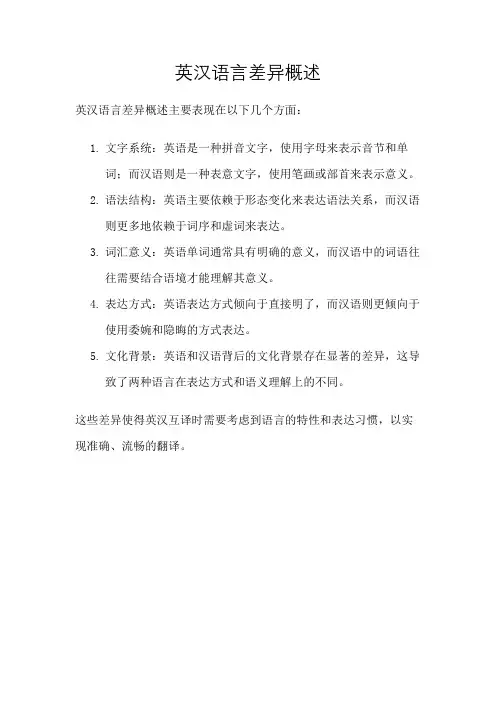
英汉语言差异概述
英汉语言差异概述主要表现在以下几个方面:
1.文字系统:英语是一种拼音文字,使用字母来表示音节和单
词;而汉语则是一种表意文字,使用笔画或部首来表示意义。
2.语法结构:英语主要依赖于形态变化来表达语法关系,而汉语
则更多地依赖于词序和虚词来表达。
3.词汇意义:英语单词通常具有明确的意义,而汉语中的词语往
往需要结合语境才能理解其意义。
4.表达方式:英语表达方式倾向于直接明了,而汉语则更倾向于
使用委婉和隐晦的方式表达。
5.文化背景:英语和汉语背后的文化背景存在显著的差异,这导
致了两种语言在表达方式和语义理解上的不同。
这些差异使得英汉互译时需要考虑到语言的特性和表达习惯,以实现准确、流畅的翻译。
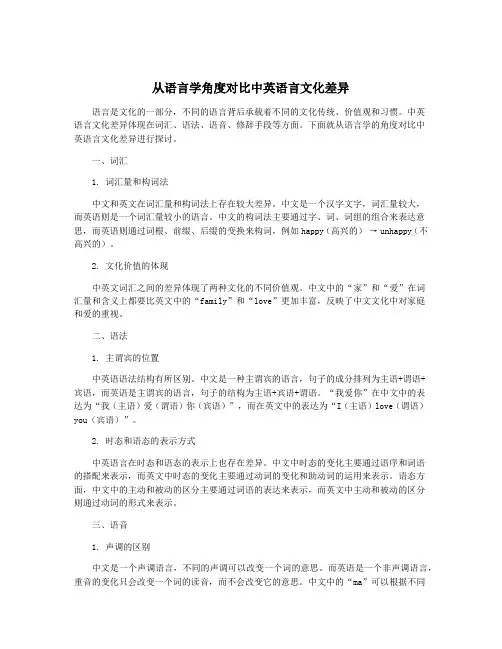
从语言学角度对比中英语言文化差异语言是文化的一部分,不同的语言背后承载着不同的文化传统、价值观和习惯。
中英语言文化差异体现在词汇、语法、语音、修辞手段等方面。
下面就从语言学的角度对比中英语言文化差异进行探讨。
一、词汇1. 词汇量和构词法中文和英文在词汇量和构词法上存在较大差异。
中文是一个汉字文字,词汇量较大,而英语则是一个词汇量较小的语言。
中文的构词法主要通过字、词、词组的组合来表达意思,而英语则通过词根、前缀、后缀的变换来构词,例如happy(高兴的)→ unhappy(不高兴的)。
2. 文化价值的体现中英文词汇之间的差异体现了两种文化的不同价值观。
中文中的“家”和“爱”在词汇量和含义上都要比英文中的“family”和“love”更加丰富,反映了中文文化中对家庭和爱的重视。
二、语法1. 主谓宾的位置中英语语法结构有所区别。
中文是一种主谓宾的语言,句子的成分排列为主语+谓语+宾语,而英语是主谓宾的语言,句子的结构为主语+宾语+谓语。
“我爱你”在中文中的表达为“我(主语)爱(谓语)你(宾语)”,而在英文中的表达为“I(主语)love(谓语)you(宾语)”。
2. 时态和语态的表示方式中英语言在时态和语态的表示上也存在差异。
中文中时态的变化主要通过语序和词语的搭配来表示,而英文中时态的变化主要通过动词的变化和助动词的运用来表示。
语态方面,中文中的主动和被动的区分主要通过词语的表达来表示,而英文中主动和被动的区分则通过动词的形式来表示。
三、语音1. 声调的区别中文是一个声调语言,不同的声调可以改变一个词的意思。
而英语是一个非声调语言,重音的变化只会改变一个词的读音,而不会改变它的意思。
中文中的“ma”可以根据不同的声调分别表示“妈”、“麻”、“马”、“吗”等不同的意思,而英语中的“ma”只有一个读音,不会改变它的意思。
2. 元音和辅音的差异中英语言在元音和辅音上存在一定的差异。
中文的元音比较丰富,有多种单元音和复元音,而英文的元音比较简单,只有一些常见的单元音和复元音。
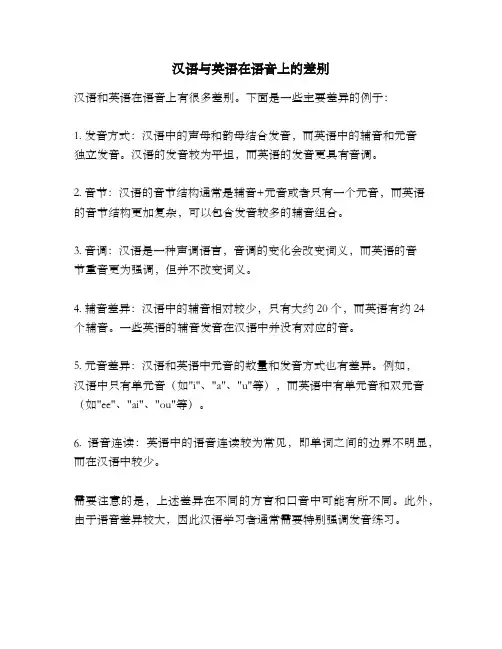
汉语与英语在语音上的差别
汉语和英语在语音上有很多差别。
下面是一些主要差异的例子:
1. 发音方式:汉语中的声母和韵母结合发音,而英语中的辅音和元音
独立发音。
汉语的发音较为平坦,而英语的发音更具有音调。
2. 音节:汉语的音节结构通常是辅音+元音或者只有一个元音,而英语的音节结构更加复杂,可以包含发音较多的辅音组合。
3. 音调:汉语是一种声调语言,音调的变化会改变词义,而英语的音
节重音更为强调,但并不改变词义。
4. 辅音差异:汉语中的辅音相对较少,只有大约20个,而英语有约24个辅音。
一些英语的辅音发音在汉语中并没有对应的音。
5. 元音差异:汉语和英语中元音的数量和发音方式也有差异。
例如,
汉语中只有单元音(如"i"、"a"、"u"等),而英语中有单元音和双元音(如"ee"、"ai"、"ou"等)。
6. 语音连读:英语中的语音连读较为常见,即单词之间的边界不明显,而在汉语中较少。
需要注意的是,上述差异在不同的方言和口音中可能有所不同。
此外,由于语音差异较大,因此汉语学习者通常需要特别强调发音练习。
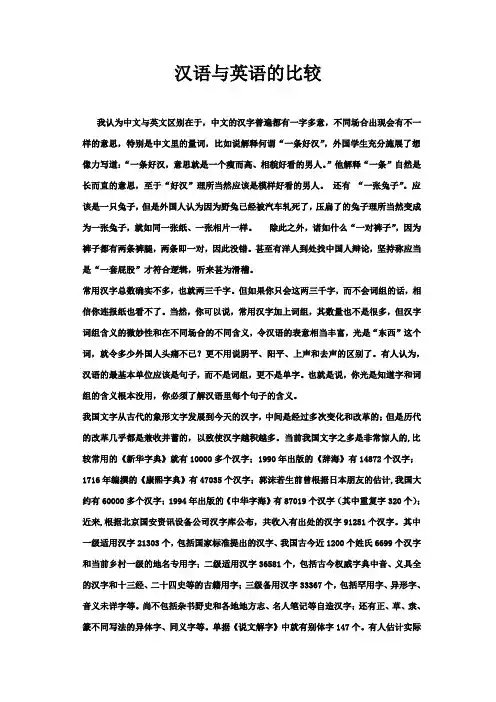
汉语与英语的比较我认为中文与英文区别在于,中文的汉字普遍都有一字多意,不同场合出现会有不一样的意思,特别是中文里的量词,比如说解释何谓“一条好汉”,外国学生充分施展了想像力写道:“一条好汉,意思就是一个瘦而高、相貌好看的男人。
”他解释“一条”自然是长而直的意思,至于“好汉”理所当然应该是模样好看的男人。
还有“一张兔子”。
应该是一只兔子,但是外国人认为因为野兔已经被汽车轧死了,压扁了的兔子理所当然变成为一张兔子,就如同一张纸、一张相片一样。
除此之外,诸如什么“一对裤子”,因为裤子都有两条裤腿,两条即一对,因此没错。
甚至有洋人到处找中国人辩论,坚持称应当是“一套屁股”才符合逻辑,听来甚为滑稽。
常用汉字总数确实不多,也就两三千字。
但如果你只会这两三千字,而不会词组的话,相信你连报纸也看不了。
当然,你可以说,常用汉字加上词组,其数量也不是很多,但汉字词组含义的微妙性和在不同场合的不同含义,令汉语的表意相当丰富,光是“东西”这个词,就令多少外国人头痛不已?更不用说阴平、阳平、上声和去声的区别了。
有人认为,汉语的最基本单位应该是句子,而不是词组,更不是单字。
也就是说,你光是知道字和词组的含义根本没用,你必须了解汉语里每个句子的含义。
我国文字从古代的象形文字发展到今天的汉字,中间是经过多次变化和改革的;但是历代的改革几乎都是兼收并蓄的,以致使汉字越积越多。
当前我国文字之多是非常惊人的,比较常用的《新华字典》就有10000多个汉字;1990年出版的《辞海》有14872个汉字;1716年编撰的《康熙字典》有47035个汉字;郭沫若生前曾根据日本朋友的估计,我国大约有60000多个汉字;1994年出版的《中华字海》有87019个汉字(其中重复字320个);近来,根据北京国安资讯设备公司汉字库公布,共收入有出处的汉字91251个汉字。
其中一级适用汉字21303个,包括国家标准提出的汉字、我国古今近1200个姓氏6699个汉字和当前乡村一级的地名专用字;二级适用汉字36581个,包括古今权威字典中音、义具全的汉字和十三经、二十四史等的古籍用字;三级备用汉字33367个,包括罕用字、异形字、音义未详字等。
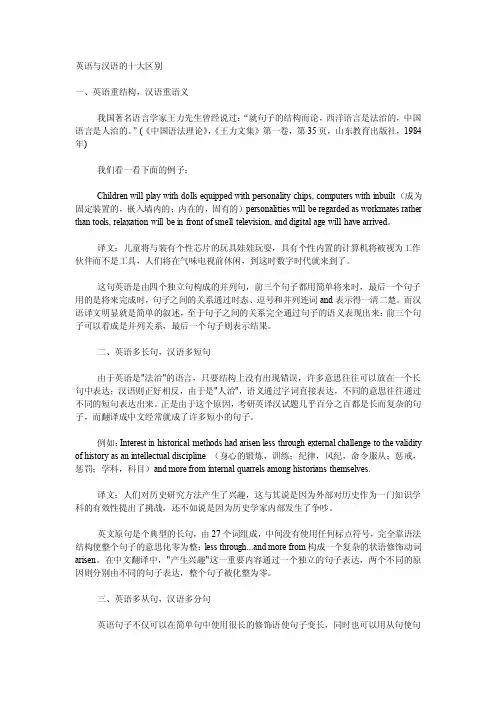
英语与汉语的十大区别一、英语重结构,汉语重语义我国著名语言学家王力先生曾经说过:“就句子的结构而论,西洋语言是法治的,中国语言是人治的。
”(《中国语法理论》,《王力文集》第一卷,第35页,山东教育出版社,1984年)我们看一看下面的例子:Children will play with dolls equipped with personality chips,computers with inbuilt(成为固定装置的,嵌入墙内的;内在的,固有的)personalities will be regarded as workmates rather than tools,relaxation will be in front of smell television,and digital age will have arrived。
译文:儿童将与装有个性芯片的玩具娃娃玩耍,具有个性内置的计算机将被视为工作伙伴而不是工具,人们将在气味电视前休闲,到这时数字时代就来到了。
这句英语是由四个独立句构成的并列句,前三个句子都用简单将来时,最后一个句子用的是将来完成时,句子之间的关系通过时态、逗号和并列连词and表示得一清二楚。
而汉语译文明显就是简单的叙述,至于句子之间的关系完全通过句子的语义表现出来:前三个句子可以看成是并列关系,最后一个句子则表示结果。
二、英语多长句,汉语多短句由于英语是"法治"的语言,只要结构上没有出现错误,许多意思往往可以放在一个长句中表达;汉语则正好相反,由于是"人治",语义通过字词直接表达,不同的意思往往通过不同的短句表达出来。
正是由于这个原因,考研英译汉试题几乎百分之百都是长而复杂的句子,而翻译成中文经常就成了许多短小的句子。
例如:Interest in historical methods had arisen less through external challenge to the validity of history as an intellectual discipline(身心的锻炼,训练;纪律,风纪,命令服从;惩戒,惩罚;学科,科目)and more from internal quarrels among historians themselves.译文:人们对历史研究方法产生了兴趣,这与其说是因为外部对历史作为一门知识学科的有效性提出了挑战,还不如说是因为历史学家内部发生了争吵。
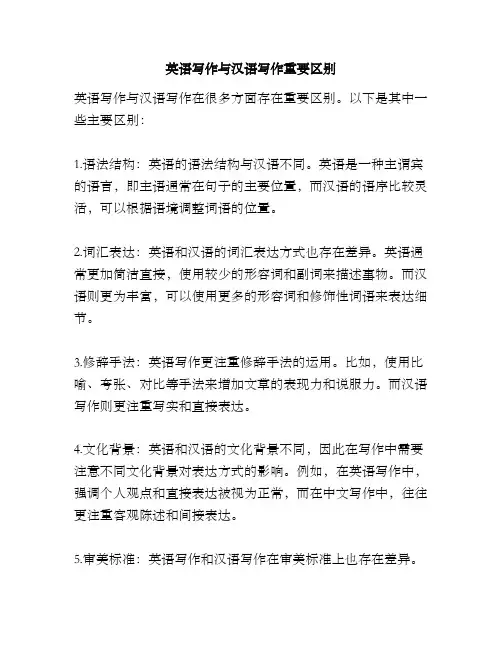
英语写作与汉语写作重要区别
英语写作与汉语写作在很多方面存在重要区别。
以下是其中一些主要区别:
1.语法结构:英语的语法结构与汉语不同。
英语是一种主谓宾的语言,即主语通常在句子的主要位置,而汉语的语序比较灵活,可以根据语境调整词语的位置。
2.词汇表达:英语和汉语的词汇表达方式也存在差异。
英语通常更加简洁直接,使用较少的形容词和副词来描述事物。
而汉语则更为丰富,可以使用更多的形容词和修饰性词语来表达细节。
3.修辞手法:英语写作更注重修辞手法的运用。
比如,使用比喻、夸张、对比等手法来增加文章的表现力和说服力。
而汉语写作则更注重写实和直接表达。
4.文化背景:英语和汉语的文化背景不同,因此在写作中需要注意不同文化背景对表达方式的影响。
例如,在英语写作中,强调个人观点和直接表达被视为正常,而在中文写作中,往往更注重客观陈述和间接表达。
5.审美标准:英语写作和汉语写作在审美标准上也存在差异。
英语写作注重逻辑思维和结构的合理性,追求简洁、明了和逻辑通顺。
而汉语写作更注重意境和修辞的美感,喜欢运用象征、比喻、双关等手法来丰富作品的艺术性。
在进行英语写作时,需要注意以上差异,并灵活运用英语的语法结构和修辞手法,同时注意与读者的文化背景和审美标准相契合。
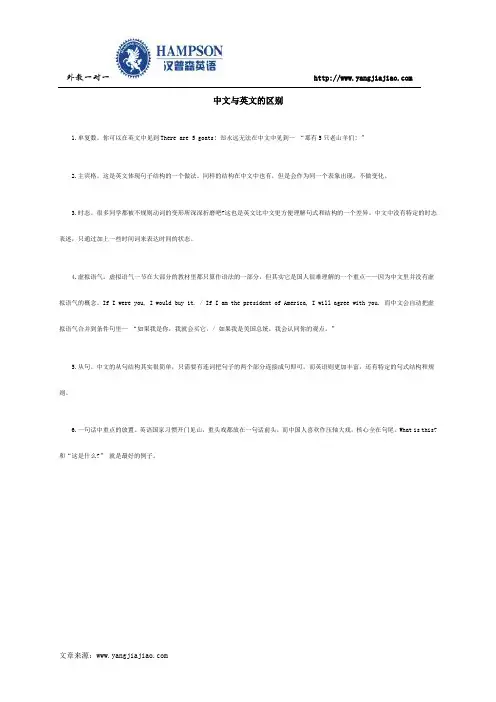
外教一对一
中文与英文的区别
1.单复数。
你可以在英文中见到There are 5 goats! 却永远无法在中文中见到—“那有5只老山羊们! ”
2.主宾格。
这是英文体现句子结构的一个做法。
同样的结构在中文中也有,但是会作为同一个表象出现,不做变化。
3.时态。
很多同学都被不规则动词的变形所深深折磨吧?这也是英文比中文更方便理解句式和结构的一个差异。
中文中没有特定的时态表述,只通过加上一些时间词来表达时间的状态。
4.虚拟语气。
虚拟语气一节在大部分的教材里都只算作语法的一部分,但其实它是国人很难理解的一个重点——因为中文里并没有虚拟语气的概念。
If I were you, I would buy it. / If I am the president of America, I will agree with you. 而中文会自动把虚拟语气合并到条件句里—“如果我是你,我就会买它。
/ 如果我是美国总统,我会认同你的观点。
”
5.从句。
中文的从句结构其实很简单,只需要有连词把句子的两个部分连接成句即可。
而英语则更加丰富,还有特定的句式结构和规则。
6.一句话中重点的放置。
英语国家习惯开门见山,重头戏都放在一句话前头,而中国人喜欢作压轴大戏,核心全在句尾。
What is this?和“这是什么?” 就是最好的例子。
文章来源:。
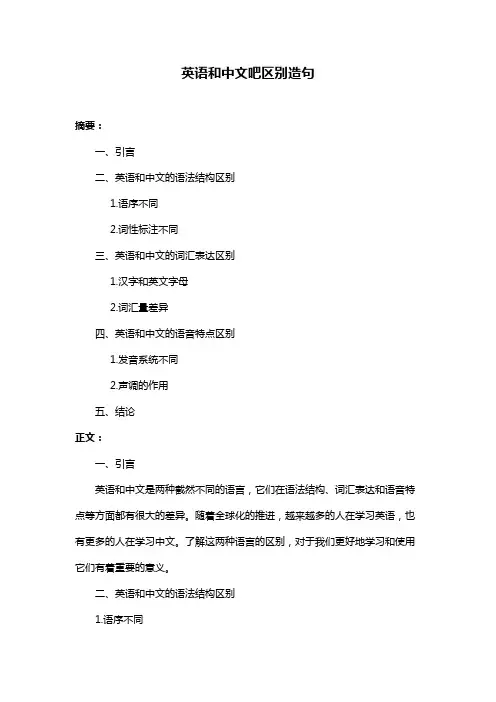
英语和中文吧区别造句摘要:一、引言二、英语和中文的语法结构区别1.语序不同2.词性标注不同三、英语和中文的词汇表达区别1.汉字和英文字母2.词汇量差异四、英语和中文的语音特点区别1.发音系统不同2.声调的作用五、结论正文:一、引言英语和中文是两种截然不同的语言,它们在语法结构、词汇表达和语音特点等方面都有很大的差异。
随着全球化的推进,越来越多的人在学习英语,也有更多的人在学习中文。
了解这两种语言的区别,对于我们更好地学习和使用它们有着重要的意义。
二、英语和中文的语法结构区别1.语序不同在英语中,通常采用主谓宾的语序,而在中文中,语序较为灵活,可以为主谓宾、主谓、宾主谓等多种形式。
2.词性标注不同英语中,名词、动词、形容词等词性有明确的标记,而中文中没有这种标记,需要通过上下文来判断词性。
三、英语和中文的词汇表达区别1.汉字和英文字母中文使用汉字作为书写系统,每个汉字都代表一个音节,而英语使用26 个英文字母组成单词,每个字母代表一个发音。
2.词汇量差异英语的词汇量非常庞大,大约有170 万左右,而中文的词汇量相对较小,大约有8 万个左右。
四、英语和中文的语音特点区别1.发音系统不同英语属于印欧语系,其发音系统较为复杂,有元音和辅音之分,而中文属于汉藏语系,其发音系统相对简单,主要是声母和韵母。
2.声调的作用中文有四个声调,声调对词语的意义具有决定性作用,而英语没有声调,其重音对词义的影响相对较小。
五、结论英语和中文在语法结构、词汇表达和语音特点等方面都有很大的差异,这些差异使得学习这两种语言具有一定的难度。
但是,随着我国在国际舞台上的地位日益提高,学习和掌握英语和中文已经成为了我们必须面对的挑战。
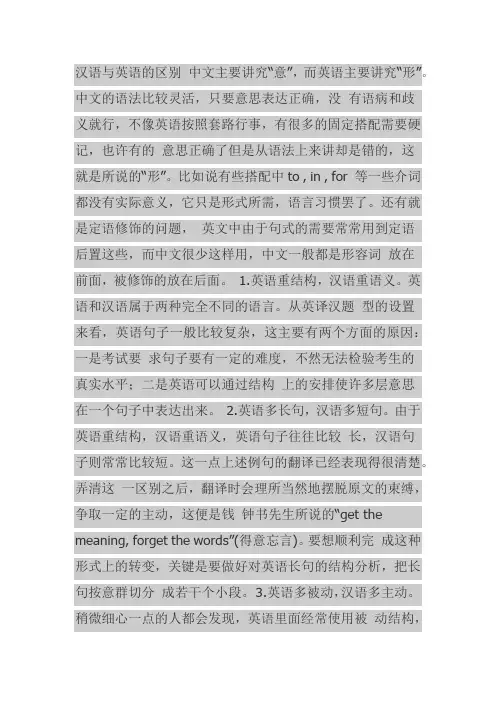
汉语与英语的区别中文主要讲究“意”,而英语主要讲究“形”。
中文的语法比较灵活,只要意思表达正确,没有语病和歧义就行,不像英语按照套路行事,有很多的固定搭配需要硬记,也许有的意思正确了但是从语法上来讲却是错的,这就是所说的“形”。
比如说有些搭配中to , in , for 等一些介词都没有实际意义,它只是形式所需,语言习惯罢了。
还有就是定语修饰的问题,英文中由于句式的需要常常用到定语后置这些,而中文很少这样用,中文一般都是形容词放在前面,被修饰的放在后面。
1.英语重结构,汉语重语义。
英语和汉语属于两种完全不同的语言。
从英译汉题型的设置来看,英语句子一般比较复杂,这主要有两个方面的原因:一是考试要求句子要有一定的难度,不然无法检验考生的真实水平;二是英语可以通过结构上的安排使许多层意思在一个句子中表达出来。
2.英语多长句,汉语多短句。
由于英语重结构,汉语重语义,英语句子往往比较长,汉语句子则常常比较短。
这一点上述例句的翻译已经表现得很清楚。
弄清这一区别之后,翻译时会理所当然地摆脱原文的束缚,争取一定的主动,这便是钱钟书先生所说的“get theme aning, forget the words”(得意忘言)。
要想顺利完成这种形式上的转变,关键是要做好对英语长句的结构分析,把长句按意群切分成若干个小段。
3.英语多被动,汉语多主动。
稍微细心一点的人都会发现,英语里面经常使用被动结构,而汉语里却很少使用被动结构。
面对这一矛盾,我们当然不能将每一个被动结构都机械地照翻,一定要根据具体情况进行适当的处理。
一、汉语成语和英语成语在逻辑上的相同点人类具有类似的情感反应和逻辑思维方式,虽然引起情感变化的原因不尽相同,但表达情感的英语成语与汉语成语却存在很多相似之处。
用心琢磨就会发现,在表达同样意思的时候,虽然所使用的词汇或比拟的事物不同,但表达了相同或相似的意思,这也使我们在理解英语成语的时候有章可循。
二、汉语成语和英语成语在形式上的相同点,汉语成语和英语成语在结构上一般是固定的。
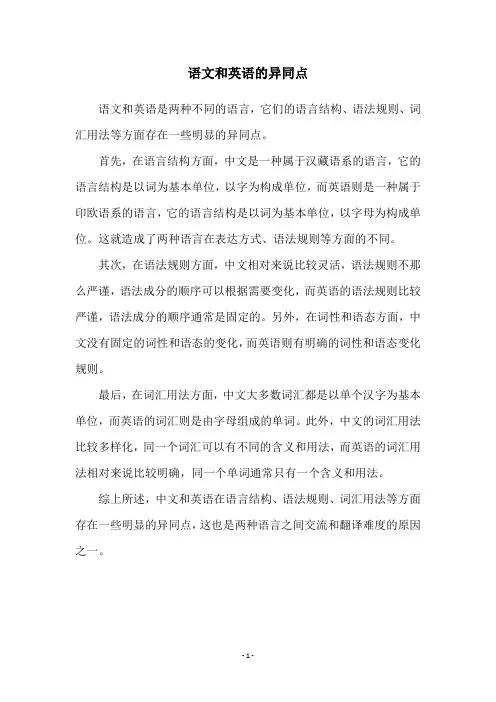
语文和英语的异同点
语文和英语是两种不同的语言,它们的语言结构、语法规则、词汇用法等方面存在一些明显的异同点。
首先,在语言结构方面,中文是一种属于汉藏语系的语言,它的语言结构是以词为基本单位,以字为构成单位,而英语则是一种属于印欧语系的语言,它的语言结构是以词为基本单位,以字母为构成单位。
这就造成了两种语言在表达方式、语法规则等方面的不同。
其次,在语法规则方面,中文相对来说比较灵活,语法规则不那么严谨,语法成分的顺序可以根据需要变化,而英语的语法规则比较严谨,语法成分的顺序通常是固定的。
另外,在词性和语态方面,中文没有固定的词性和语态的变化,而英语则有明确的词性和语态变化规则。
最后,在词汇用法方面,中文大多数词汇都是以单个汉字为基本单位,而英语的词汇则是由字母组成的单词。
此外,中文的词汇用法比较多样化,同一个词汇可以有不同的含义和用法,而英语的词汇用法相对来说比较明确,同一个单词通常只有一个含义和用法。
综上所述,中文和英语在语言结构、语法规则、词汇用法等方面存在一些明显的异同点,这也是两种语言之间交流和翻译难度的原因之一。
- 1 -。
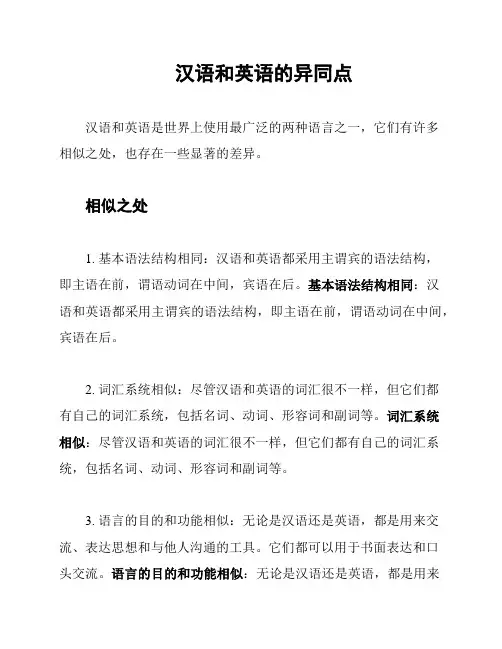
汉语和英语的异同点汉语和英语是世界上使用最广泛的两种语言之一,它们有许多相似之处,也存在一些显著的差异。
相似之处1. 基本语法结构相同:汉语和英语都采用主谓宾的语法结构,即主语在前,谓语动词在中间,宾语在后。
基本语法结构相同:汉语和英语都采用主谓宾的语法结构,即主语在前,谓语动词在中间,宾语在后。
2. 词汇系统相似:尽管汉语和英语的词汇很不一样,但它们都有自己的词汇系统,包括名词、动词、形容词和副词等。
词汇系统相似:尽管汉语和英语的词汇很不一样,但它们都有自己的词汇系统,包括名词、动词、形容词和副词等。
3. 语言的目的和功能相似:无论是汉语还是英语,都是用来交流、表达思想和与他人沟通的工具。
它们都可以用于书面表达和口头交流。
语言的目的和功能相似:无论是汉语还是英语,都是用来交流、表达思想和与他人沟通的工具。
它们都可以用于书面表达和口头交流。
差异之处1. 语音系统不同:汉语和英语在语音系统上存在很大差异。
汉语采用声调来区分词义,而英语则依靠重音和音位来区分词义。
语音系统不同:汉语和英语在语音系统上存在很大差异。
汉语采用声调来区分词义,而英语则依靠重音和音位来区分词义。
2. 词序不同:汉语和英语的词序也有所不同。
汉语的词序比较自由,可以灵活调整,而英语的词序则较为固定。
词序不同:汉语和英语的词序也有所不同。
汉语的词序比较自由,可以灵活调整,而英语的词序则较为固定。
3. 句子结构不同:汉语和英语在句子结构上也有一些差异。
汉语更注重上下文的建立,常采用省略和倒装等形式,而英语则更注重句子的顺序和完整性。
句子结构不同:汉语和英语在句子结构上也有一些差异。
汉语更注重上下文的建立,常采用省略和倒装等形式,而英语则更注重句子的顺序和完整性。
4. 文化和思维方式差异:汉语和英语所处的文化背景和思维方式也有很大的差异。
汉语强调整体和细节之间的关系,而英语更注重逻辑和思维的线性发展。
文化和思维方式差异:汉语和英语所处的文化背景和思维方式也有很大的差异。
英语和汉语的十大差异了解英汉两门语言的差异是做好翻译的关键一、英语重结构,汉语重语义我国著名语言学家王力先生曾经说过:“就句子的结构而论,西洋语言是法治的,中国语言是人治的。
”(《中国语法理论》,《王力文集》第一卷,第35页,山东教育出版社,1984年)我们看一看下面的例子:Children will play with dolls equipped with personality chips, computers with inbuilt (成为固定装置的,嵌入墙内的;内在的,固有的)personalities will be regarded as workmates rather than tools, relaxation will be in front of smell television, and digital age will have arrived。
译文:儿童将与装有个性芯片的玩具娃娃玩耍,具有个性内置的计算机将被视为工作伙伴而不是工具,人们将在气味电视前休闲,到这时数字时代就来到了。
这句英语是由四个独立句构成的并列句,前三个句子都用简单将来时,最后一个句子用的是将来完成时,句子之间的关系通过时态、逗号和并列连词and表示得一清二楚。
而汉语译文明显就是简单的叙述,至于句子之间的关系完全通过句子的语义表现出来:前三个句子可以看成是并列关系,最后一个句子则表示结果。
二、英语多长句,汉语多短句由于英语是"法治"的语言,只要结构上没有出现错误,许多意思往往可以放在一个长句中表达;汉语则正好相反,由于是"人治",语义通过字词直接表达,不同的意思往往通过不同的短句表达出来。
正是由于这个原因,考研英译汉试题几乎百分之百都是长而复杂的句子,而翻译成中文经常就成了许多短小的句子。
例如:Interest in historical methods had arisen less through external challenge to the validity of history as an intellectual discipline (身心的锻炼,训练;纪律,风纪,命令服从;惩戒,惩罚;学科,科目)and more from internal quarrels among historians themselves.译文:人们对历史研究方法产生了兴趣,这与其说是因为外部对历史作为一门知识学科的有效性提出了挑战,还不如说是因为历史学家内部发生了争吵。
浅谈英语与汉语的差异摘要作为英语学习者,不断地学习其语言文字,思维方式,文化背景,语法,发音是必要的,但如果能在了解英语的基础上,再结合自身所学的汉语,体会两种语言的差异,对于英语的学习是很有帮助的,本文主要从词汇,语法,思维,文化等的方面介绍英语与汉语的差异,便于英语方面的学习,也有助于对英语文化的进一步理解。
关键词英语汉语差异一、英语与汉语思维上的差异中国人习惯于形象思维,汉语是可以想象的,因为中国人强调直觉和图像;英语语言更加功能化,因为英欧语系强调理性和逻辑。
中文写成的字符最初的形式里是事物或观念的图像。
在当前高度发达的形式中,汉字不是用图片传递文字,而是用生动形象的意象来传递想法的复杂手段。
例如,“水”就像是船在海上漂着,“瓜”(melon)是根据植物果实的树干二引申出来的汉字,“森”是由三个木组成,意味着大片的树木覆盖大地。
一些词汇的意思,我们可以从汉字的字形而直接理解其含义,汉语的描述能很生动的介绍图像,形状和材;而在英语中,他只具有实际意义和作用。
汉语经常把图像作为隐喻或抽象的观念来表达感情。
“蚕食”用蚕宝宝吃桑叶来慢慢啃咬宵夜的方式来比喻逐步侵略和占领。
“酸甜苦辣”往往描述了食物的味道,有时我们会用在对于生活的描述上,生动的代表了生活的滋味。
中国人偏向综合思维,西方人偏向分析思维,汉语的理解更多的依赖整体表达功能,往往凭主观直觉,英语有一个显著的特点是词汇丰富,汉语则是动词丰富,因此英语中用介词的地方,汉语常常使用动词。
汉语注重思维形态上的主观性,认为任何行为都可能是人的行为主体完成的,折射在表达形式上,西方人主张理性分析,保持物我之间的距离,重视自然客观,思维目标常常指向外界。
中国人偏向曲线思维,习惯跳动,迂回,环绕的方式,而西方的思维模式是直线型的,是按照直线逻辑思维方式进行的二、英语与汉语文字上的差异中英文文字之间的差别主要有三条。
首先是两种文字的记录方式不同,英文记录文字的最小单位是音素,而用来记录音素的基本符号是字母或字母组合;而中文记录的最小单位音素是音节,用来记录汉字的基本符号是汉字,每一个汉字记录汉语中的一个音节。
论汉语语法与英语语法差异
汉语和英语是两种完全不同的语言,具有各自独特的语法结构、语法规则和语法习惯。
下面是汉语语法与英语语法差异的几个方面:
一、词序不同
中文的语法结构是以主谓宾为主,而英语的语法结构则是以主语+谓语+宾语为主。
因此,在汉语中,动词在句子中的位置通常比英语更靠前,如:“我喜欢吃中餐”与“I
like to eat Chinese food”,在汉语中的“喜欢”和“吃”都在英语中的“like”之前
出现。
二、句子结构不同
中文和英语在句子结构方面也有很大的区别。
中文中容易出现重复使用主语和宾语的
现象,如:“我爱你,你也爱我。
”而在英语中,会使用代词来避免重复,如“I love you, and you love me too.”此外,英语中还有复合句的结构,而汉语中则没有。
三、动词时态不同
汉语的动词时态相对简单,常常只用一个动词来表示过去、现在和未来,如“我吃饭”可以表示过去、现在和未来,而英语则需要使用不同的动词时态来表示不同的时间点。
例如,“I eat”表示现在,“I ate”表示过去,“I will eat”表示未来。
四、语法重音不同
在汉语中,句子的重音通常是由语调来决定的,而在英语中,重音则更多地依赖于词
汇本身的音节结构。
例如,在英语中,“photographer”这个词汇的重音在第二个音节上,而在汉语中不存在这种音节重音的现象。
总的来说,汉语和英语在语法方面存在着很大的差异,这使得汉语学习者在学习英语
时经常会遇到一些困难,需要不断加强练习,熟悉和掌握英语的语法规则和结构。
一、语言差异与文化差异文化背景不同,操不同语言的人在交谈时,常常发生下列情况:由于文化上的不同,即使语言准确无误,也会产生误会。
对于不同的人们,同一个词或同一种表达方式可以具有不同的意义。
由于文化上的差异,谈一个严肃的问题时,由于一句话说得不得体,可以使听者发笑,甚至捧腹大笑;一句毫无恶意的话可以使对方不快或气愤;由于文化上的差异,在国外演讲的人经常发现听众对他讲的某个笑话毫无反应,面无表情,鸦雀无声;然而,在国内,同一个笑话会使听众笑得前仰后合。
语言是文化的一部分,并对文化起着重要作用。
有些社会学家认为,语言是文化的基石——没有语言,就没有文化;从另一个方面看,语言又受文化的影响,反映文化。
可以说,语言反映一个民族的特征,它不仅包含着该民族的历史和文化背景,而且蕴藏着该民族对人生的看法、生活方式和思维方式。
语言与文化互相影响,互相作用;理解语言必须了解文化,理解文化必须了解语言。
文化是形形色色的,语言也是多种多样的。
由于文化和语言上的差别。
互相了解不是一件容易的事,不同文化问的交流常常遇到困难。
学习一种外语不仅要掌握语音、语法、词汇和习语,而且还要知道择这种语言的人如何看待事物,如何观察世界;要了解他们如何用他们的语言来反映他们社会的思想、习惯、行为;要懂得他们的“心灵之语言”,即了解他们社会的文化。
实际上,学习语言与了解语言所反映的文化是分不开的。
这里我们粗略探讨一下英语国家的人(或以英语为本族语的人,以美国人为代表)与中国人之间的文化差异。
这种文化上的差异是多方面的,我们只围绕语言交际这一方面进行考察。
至于其他,如生活方式、衣着打扮、举止行为、饮食习性等等与语言交际无关的差异,则不赘述。
论汉语语法与英语语法差异
中文和英语是两种不同的语言,它们的语法存在许多差异。
以下是几个主要的区别:
1. 词序不同
中文的基本语序是主谓宾,而英语的基本语序是主语谓语宾语。
例如,汉语中的“我
喜欢你”在英语中应该是“我你喜欢”。
2. 动宾结构不同
在汉语中,动词和宾语的关系非常紧密,宾语通常紧跟在动词后面。
但在英语中,动
词和宾语之间通常有其他成分,比如副词或介词短语。
例如,“我吃饭”在英语中应该是“I eat food”。
3. 经验与抽象概念不同
英语语法更偏向于抽象概念和规则的表达,而中文更加强调经验和感觉的表达。
因此,在中文中,经常使用方式状语来描述动作的细节,如“轻轻地摸”、“缓缓地走”,而在
英文中,则更倾向于使用副词来表达同样的含义,如“gently touch”、“walk slowly”。
在汉语中,一个词可以作为不同的词性出现,具有更多的灵活性。
例如,“好”可以
作为形容词、副词和动词使用。
在英语中,词的词性通常是固定的,难以灵活转换。
虚词在两种语言中的使用方式和频率也有所不同。
在中文中,经常使用的虚词有“的”、“地”、“得”等,这些虚词的使用可以使句子更加完整、清晰。
在英语中,常
用虚词有“the”、“a”、“an”等冠词,它们用于限定名词的范围。
总的来说,中文和英语的语法存在很多差异,这些差异可以反映出两种文化的不同。
因此,对于学习汉语的人来说,理解这些差异是非常重要的。
汉语和英语在语法方面的异同
汉语和英语在语法方面的异同主要有以下几点:
一、语序的不同
汉语的句子构成主要是主谓宾的表达方式,句子的核心词汇位于句首,而英语则以主语为句首。
二、动词的变形不同
汉语没有语法性动词变形,而英语有各种语法性变形比如实义动词be动词am、is、are、was、were;is、are之前一般都需要加上实义动词的“s”;am、is、are在疑问句和否定句中也有变形。
三、定语从句的不同
汉语定语从句没有that,而英语定语从句中一般都要使用that。
四、介词的性质不同
汉语介词多由动词构成,而英语介词的性质多由副词组成。
五、形容词的位置不同
汉语形容词的位置相对随意,而英语形容词的位置一般在名词的前面。
Some differences between Chinese and EnglishHow many languages in the world? well the answer is more than what you have thought,I can only tell you there are 7 language families in the world, but it is sure that there are only 140 kinds of language with a user number of more than 100million, among all the languages, Chinese has more users than any other ones, accounting for about 1/5 of the world population. That’s also the reason why Chinese is one of the six working language of the united nations, the other five ones being English,Russian,german,French and Spanish. While there are also some languages which are only used by thousands or even hundreds of people,like native American Indian language,Chinese hezhe language,etc.Since Chinese and English are the most familiar languages to us and they are both playing a very influencial parts in world stage,today id like to introduce the differences between them.considering that these languages have developed largely in separation from each other. Chinese and English differ in terms of how they are written, how they sound, and their grammatical structures and rules.nguages and DialectsChinese can be an ambiguous term. There are many dialects of Chinese, including Mandarin, Wu, Min, and Cantonese. Chinese can refer to the language family which is made up of these many dialects."English" is a term that refers to a single language, rather than a language family. There are dialects of English, such as American English, British English, and Manx English, but these dialects are largely mutually intelligible. This is unlike Chinese dialects, which can be very different in terms of phonetics, lexicon, and grammar.2.Writing SystemsThe fundamental difference between the Chinese and English writing systems is that Chinese uses a logographic writing system, while English uses an alphabetic writing system. An alphabetic writing system is one which uses individual letters—each of which roughly corresponds to particular phonemes—to "spell out" how words sound.A logographic system is made up of visual symbols which represent words but not sounds. This means that the pronunciation of Chinese characters is not implied by the way the character is written.3.The Pronunciation of Chinese and EnglishUnsurprisingly, some of the sounds of Chinese and English are similar. For example, b, k, p, d, and t (as expressed in the Hanyu Pinyin romanization system) share essentially identical pronunciation in both Chinese and English. However, other Chinese sounds such as x, ü, and q do not exist in English's phonetic inventory.Many full Chinese syllables (such as pang, xiong,and dun) are not found in English. Likewise, consonant clusters (such as those in train, backed, and thread) are never found in Chinese.4.Chinese and English Grammar DifferencesUnlike English, there is no grammatical tense in Chinese. For example, while the English verb "do" becomes "did" to express past tense, Chinese verbs do not change in this way. Instead, Chinese relies on expressing aspect. For example, the aspect particle "le" can be used after a verb or at the end of a sentence to imply that an action has been completed. Expressing completion and expressing tense are different things.Chinese does not, in general, pluralize words. In English, there can be "one dog" or "two dogs",with the "s" indicating plural. But in Chinese, there is "one dog" and "two dog". That is, the noun "dog" (in Chinese, gou) does not change when the number changes. However, the suffix "-men" can be used in Chinese to indicate plural in pronouns such as "he", "she", and "it", and in words such as "classmate."One major similarity between English and Chinese is that they are both SVO languages, as they both follow the same basic order of Subject-Verb-Object. For example, the English sentence "I eat pumpkins" has identical structure in Chinese.5.More Language DifferencesEnglish is almost always written from left to right. However, Chinese can be written from top to bottom, right to left, as well as left to right.English has a significant number of polysyllabic words. For example, even the word "polysyllabic" has 5 syllables. On the other hand, one Chinese character is never longer than one syllable. The majority of Chinese words are made up of two characters (and therefore two syllables), but Chinese words are not commonly tri- or polysyllabic.Chinese and English differ in terms of dialects, orthography, phonetics, grammar, and in many other important ways. While the above examples only begin to describe the ways these languages differ, they provide a fundamental understanding of the major differences and similarities between Chinese and English.。